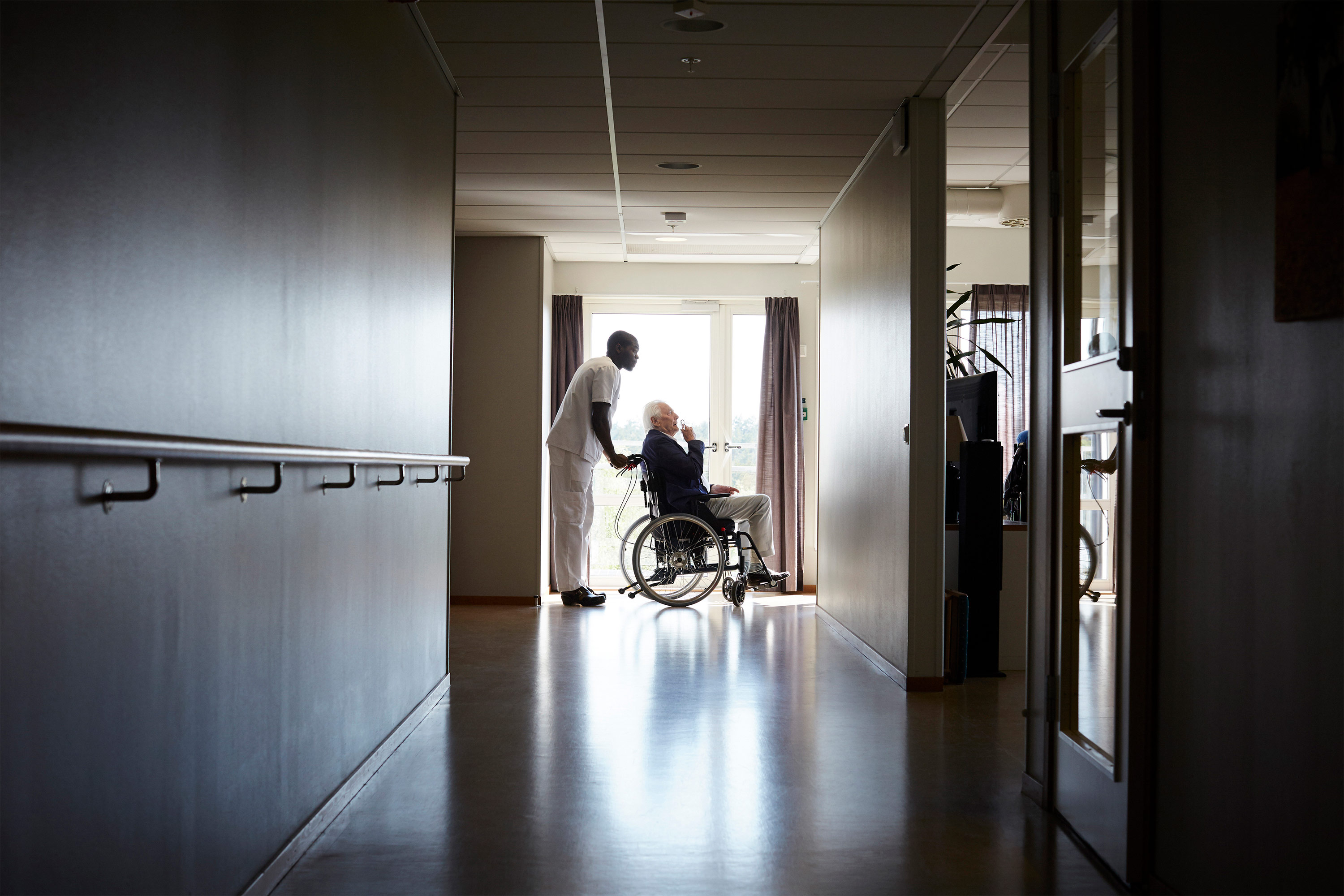When powerful wind gusts created threatening wildfire conditions one day near Boulder, Colorado, the state’s largest utility cut power to 52,000 homes and businesses — including Frasier, an assisted living and skilled nursing facility.
It was the first time Xcel Energy preemptively switched off electricity in Colorado as a wildfire prevention tool, according to a company official. The practice, also known as public safety power shut-offs, has taken root in California and is spreading elsewhere as a way to keep downed and damaged power lines from sparking blazes and fueling the West’s more frequent and intense wildfires.
In Boulder, Frasier staff and residents heard about the planned outage from news reports. A Frasier official called the utility to confirm and was initially told the home’s power would not be affected. The utility then called back to say the home’s power would be cut, after all, said Tomas Mendez, Frasier’s vice president of operations. The home had just 75 minutes before Xcel Energy shut off the lights on April 6.
Staff rushed to prepare the 20-acre campus home to nearly 500 residents. Generators kept running the oxygen machines, most refrigerators and freezers, hallway lights, and Wi-Fi for phones and computers. But the heating system and some lights stayed off as the overnight temperature dipped into the 30s.
Power was restored to Frasier after 28 hours. During the shut-off, staff tended to nursing home and assisted living residents, many with dementia, Mendez said.
“These are the folks that depend on us for everything: meals, care, and medications,” he said.
Not knowing when power would be restored, even 24 hours into the crisis, was stressful and expensive, including the next-day cost of refilling fuel for two generators, Mendez said.
“We’re lucky we didn’t have any injuries or anything major, but it is likely these could happen when there are power outages — expected or unexpected. And that puts everyone at risk,” Mendez said.
As preemptive power cuts become more widespread, nursing homes are being forced to evaluate their preparedness. But it shouldn’t be up to the facilities alone, according to industry officials and academics: Better communication between utilities and nursing homes, and including the facilities in regional disaster preparedness plans, is critical to keep residents safe.
“We need to prioritize these folks so that when the power does go out, they get to the front of the line to restore their power accordingly,” said David Dosa, chief of geriatrics and professor of medicine at UMass Chan Medical School in Worcester, Massachusetts, of nursing home residents.
Restoring power to hospitals and nursing homes was a priority throughout the windstorm, wrote Xcel Energy spokesperson Tyler Bryant in an email. But, he acknowledged, public safety power shut-offs can improve, and the utility will work with community partners and the Colorado Public Utilities Commission to help health facilities prepare for extended power outages in the future.
When the forecast called for wind gusts of up to 100 mph on April 6, Xcel Energy implemented a public safety power shut-off. Nearly 275,000 customers were without power from the windstorm.
Officials had adapted after the Marshall Fire killed two people and destroyed or damaged more than 1,000 homes in Boulder and the neighboring communities of Louisville and Superior two and a half years ago. Two fires converged to form that blaze, and electricity from an Xcel Energy power line that detached from its pole in hurricane-force winds “was the most probable cause” of one of them.
“A preemptive shutdown is scary because you don’t really have an end in mind. They don’t tell you the duration,” said Jenny Albertson, director of quality and regulatory affairs for the Colorado Health Care Association and Center for Assisted Living.
More than half of nursing homes in the West are within 3.1 miles of an area with elevated wildfire risk, according to a study published last year. Yet, nursing homes with the greatest risk of fire danger in the Mountain West and Pacific Northwest had poorer compliance with federal emergency preparedness standards than their lower-risk counterparts.
Under federal guidelines, nursing homes must have disaster response plans that include emergency power or building evacuation. Those plans don’t necessarily include contingencies for public safety power shut-offs, which have increased in the past five years but are still relatively new. And nursing homes in the West are rushing to catch up.
In California, a more stringent law to bring emergency power in nursing homes up to code is expected by the California Association of Health Facilities to cost over $1 billion. But the state has not allocated any funding for these facilities to comply, said Corey Egel, the association’s director of public affairs. The association is asking state officials to delay implementation of the law for five years, to Jan. 1, 2029.
Most nursing homes operate on a razor’s edge in terms of federal reimbursement, Dosa said, and it’s incredibly expensive to retrofit an old building to keep up with new regulations.
Frasier’s three buildings for its 300 residents in independent living apartments each have their own generators, in addition to two generators for assisted living and skilled nursing, but none is hooked up to emergency air conditioning or heat because those systems require too much energy.
Keeping residents warm during a minus-10-degree night or cool during two 90-degree days in Boulder “are the kinds of things we need to think about as we consider a future with preemptive power outages,” Mendez said.
Federal audits of emergency preparedness at nursing homes in California and Colorado found facilities lacking. In Colorado, eight of 20 nursing homes had deficiencies related to emergency supplies and power, according to the report. These included three nursing homes without plans for alternate energy sources like generators and four nursing homes without documentation showing generators had been properly tested, maintained, and inspected.
For Debra Saliba, director of UCLA’s Anna and Harry Borun Center for Gerontological Research, making sure nursing homes are part of emergency response plans could help them respond effectively to any kind of power outage. Her study of nursing homes after a magnitude 6.7 earthquake that shook the Los Angeles area in 1994 motivated LA County to integrate nursing homes into community disaster plans and drills.
Too often, nursing homes are forgotten during emergencies because they are not seen by government agencies or utilities as health care facilities, like hospitals or dialysis centers, Saliba added.
Albertson said she is working with hospitals and community emergency response coalitions in Colorado on disaster preparedness plans that include nursing homes. But understanding Xcel Energy’s prioritization plan for power restoration would also help her prepare, she said.
Bryant said Xcel Energy’s prioritization plan for health facilities specifies not whether their electricity will be turned off during a public safety power shut-off — but how quickly it will be restored.
Julie Soltis, Frasier’s director of communications, said the home had plenty of blankets, flashlights, and batteries during the outage. But Frasier plans to invest in headlamps for caregivers, and during a town hall meeting, independent living residents were encouraged to purchase their own backup power for mobile phones and other electronics, she said.
Soltis hopes her facility is spared during the next public safety power shut-off or at least given more time to respond.
“With weather and climate change, this is definitely not the last time this will happen,” she said.
This article was produced by KFF Health News, a national newsroom that produces in-depth journalism about health issues and is one of the core operating programs at KFF — the independent source for health policy research, polling, and journalism.





















Discussion about this post